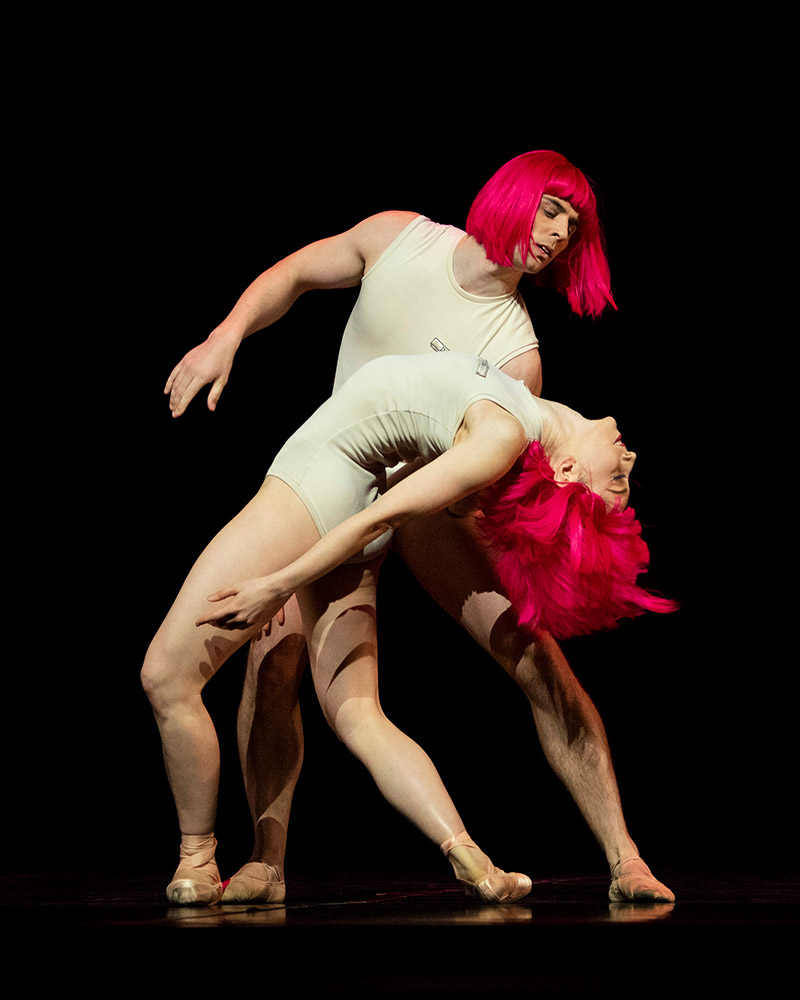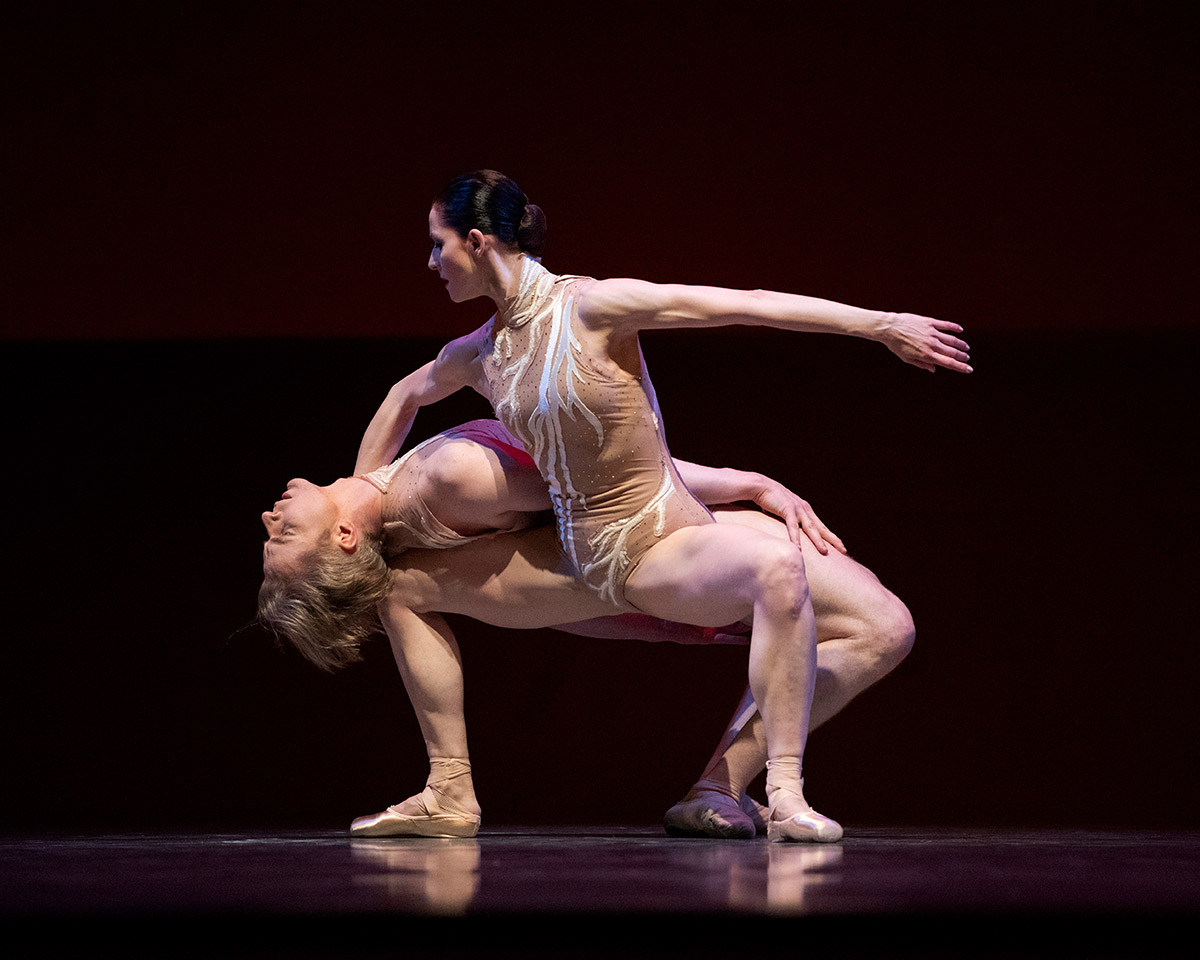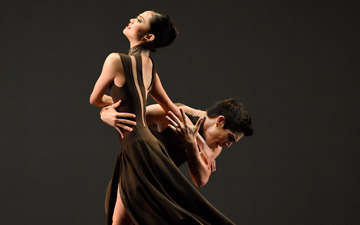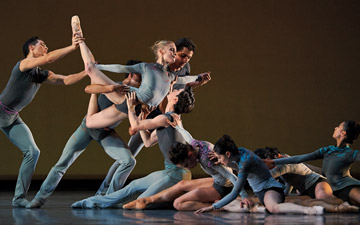
© Erik Tomasson. (Click image for larger version)
San Francisco Ballet
Dance Innovations: The Infinite Ocean, The Big Hunger (premiere), Etudes
★★★✰✰
San Francisco, War Memorial Opera House
23 February 2020
www.sfballet.org
Another eclectic repertory mix from San Francisco Ballet, Program 3 – Dance Innovations saw its final performance this past Sunday afternoon. Created for the 2018 Unbound Festival, Edwaard Liang’s The Infinite Ocean was on deck as was Harald Lander’s 1948 tribute to ballet class, Etudes. While I enjoyed both (the former a bit more than the latter), I was most excited to experience Trey McIntyre’s latest premiere, The Big Hunger. As this was the end of the run, much buzz had been circulating about the piece – strong responses, positive and negative. After seeing it, I would say I don’t fall solely into one camp; my impressions were more mixed. There were parts I adored and elements that didn’t resonate as much.
Where Hunger excelled was in the cohesiveness of concept. From beginning to end, it felt like we were watching a dystopian mystery. I can’t say what was being solved or sought, but I wanted to watch the search. Danced by a cast of fourteen, a posse of troopers in hot pink wigs marched in and out of the scene. Intense facial stares communicated that something was afoot. Exit imagery – neon green signage, graffiti, a giant chalked running pedestrian – factored heavily into the set design (by Thomas Mika, who also did the costumes). Did these doorways provide escape or possibility? Smoked poured onto the stage; strobe lights edited how much of the action was visible. And the Prokofiev score! Conducted by Martin West, featuring pianist Yekwon Sunwoo, the dramatic dissonances, cluster chords, pounding bass notes and frenetic arpeggiated passages were tempestuously ominous. Besides music, I’m not typically pulled towards such theatrical devices; in fact, I often find them a distraction. But here, the combination of elements was intoxicating.

© Erik Tomasson. (Click image for larger version)
Choreographically, however, Hunger did leave me wanting. That’s not to say that there wasn’t compelling phrase material or striking imagery, there was. Robotic, mechanized motions; extreme flexion juxtaposed against classical lines; frenzied pedestrianism. But whether a duet or group sequence, the work seemed to remain the same – dynamically and vocab-wise – for its entire thirty plus minutes. Too much so for me.
Due to a hefty train delay, I nearly missed Ocean, the afternoon’s opener. I’m so glad I made it, because Liang’s composition was indeed the strongest part of the program. Emotionally layered and choreographically textured, the ensemble work for twelve mined, “the space between life and death,” as relayed by the program notes. Haunting and uplifting throughout, Liang artistically investigated how each individual might navigate this ‘in between’ state. No two performances were the same. Reactions, intention and embodiment were unique, each dancer reminding the audience that approaching this liminal state would be and will be a distinctly personal experience. Framed by an enormous bright orange sun, the opening moments found the dancers surveying their surroundings. Walking towards the orb, they turned back and glanced around, on a journey together and yet, very much at their own pace. Lush, creative phrases grew out of the quiet; contrasting timings again expressing individuality. Classical syntax was modified with extreme postures, including a favorite that has stuck with me for a decade, since I saw The Washington Ballet in Liang’s Wunderland. On pointe in a deep second position plié, the women hinge forward, their arms extending like bird wings or spider legs.

© Erik Tomasson. (Click image for larger version)
Danced by Sofiane Sylve and Tiit Helimets, Ocean’s central duet was spellbinding. The choreography had an acrobatic, figure skating kind of feel, like the pair was gliding on frozen water beneath a bright sun – tranquil, unhurried, yet charged. Subsequent groupings added further tonal dimension to the picture. Elizabeth Powell and Max Cauthorn were almost wistful; Wona Park and Steven Morse, defiant and determined. A pas de trois for Julia Rowe, Sean Bennett and Myles Thatcher conveyed an enthusiastic energy, though it did have some awkward partnering transitions. In the end, the entire group decided to go and see what the next chapter had in store. One by one they traveled towards that horizon. Some walked fast, some lingered, some ran; again, each on their own terms. And when Park, the last dancer to leave, leaped at full-speed into the unknown, a profound sense of exhilaration and risk washed over the space.

© Erik Tomasson. (Click image for larger version)
I like Lander’s Etudes. Any piece that explores ballet technique and form is a winner in my book. It’s also a nice touch that Knudåge Riisager’s score takes its inspiration from Carl Czerny, who composed a pedagogical collection for piano still widely used today. The dance is about mastery and so is the music. Following the progression of ballet class through barre, center, port de bras, partnering, petit allegro, batterie and grand allegro, Etudes feels pure, sacred and spiritual. Like you’re in a church, engaging with a deeply known, daily practice. I find it both meditatively soothing and technically impressive. At the same time, I can see how it isn’t everyone’s cup of tea. At fifty minutes, it’s much too long. Though comprised of beautiful, delicate dancing, the middle section of Romantic era ballet, lags. And the flow of the piece is constantly interrupted by break after break after break. But even if it’s not for you, that final pose, where forty dancers reach their arms heavenward, sure is something.

















You must be logged in to post a comment.